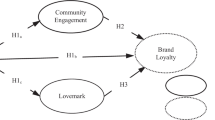Abstract
Marketers have started to recognize the potential of social media influencers (SMIs) and engage in SMI marketing, which is a strategy that uses the influence of SMIs as opinion leaders to drive consumers’ brand awareness, brand image and brand-related behavior. In addition to SMI selection criteria such as number of followers, costs per post, engagement rate or audience characteristics, practitioners are also confronted with the decision problem of choosing the type of SMI based on their origin of fame, which refers to the way SMIs became known to their audience. Two types of SMIs can be distinguished based on their origin of fame. The first type is celebrities who became famous outside of social media (e.g., by being singers, actors or athletes). Because these SMIs have a non-social media origin of fame, they are referred to as “non-original SMIs”. The second type is celebrities who became famous in social media (e.g., by presenting their lifestyle). Because these SMIs have a social media origin of fame (e.g., “instafamous”), they are referred to as “original SMIs”.
To explain the effects of SMIs’ origin of fame on social media users’ purchase behavior, this study draws on the concept of identification. In this context, identification is defined as the adoption of attitudes and behaviors of media personae through the process of social influence. With similarity and wishful identification, two distinct types of identification have been discussed in the literature. While the object of similarity identification are media personae that are similar to actual self of the media user, the object of wishful identification are media personae that are similar to the ideal self of the media user. In which type of identification media users engage depends on their level of self-esteem. While the favorite media persona of media users with low self-esteem is closer to their ideal self (i.e., wishful identification), the favorite media persona of media users with high self-esteem is closer to their actual self (i.e., similarity identification).
This study investigates if social media users’ self-esteem moderates the effect of SMIs’ origin of fame on social media users’ purchase behavior. It thus aims to examine the effectiveness of the type of SMI based on social media users’ self-esteem. The results of an online experiment with 129 social media users in Russia reveal that non-original SMIs affect social media users’ purchase intentions stronger than original SMIs if social media users have low self-esteem. In contrast, original SMIs affect social media users’ purchase intentions stronger than non-original SMIs if social media users have high self-esteem.
Access this chapter
Tax calculation will be finalised at checkout
Purchases are for personal use only
Similar content being viewed by others
Author information
Authors and Affiliations
Corresponding author
Editor information
Editors and Affiliations
Rights and permissions
Copyright information
© 2022 The Author(s), under exclusive license to Springer Nature Switzerland AG
About this paper
Cite this paper
Piehler, R., Schade, M., Sinnig, J., Burmann, C. (2022). Traditional Celebrity or Instafamous Starlet? The Role of Origin of Fame in Social Media Influencer Marketing: An Abstract. In: Allen, J., Jochims, B., Wu, S. (eds) Celebrating the Past and Future of Marketing and Discovery with Social Impact. AMSAC-WC 2021. Developments in Marketing Science: Proceedings of the Academy of Marketing Science. Springer, Cham. https://doi.org/10.1007/978-3-030-95346-1_153
Download citation
DOI: https://doi.org/10.1007/978-3-030-95346-1_153
Published:
Publisher Name: Springer, Cham
Print ISBN: 978-3-030-95345-4
Online ISBN: 978-3-030-95346-1
eBook Packages: Business and ManagementBusiness and Management (R0)




